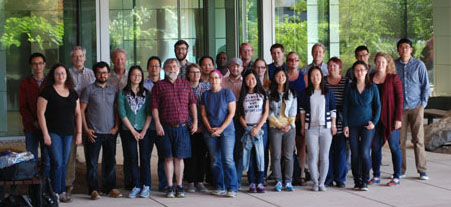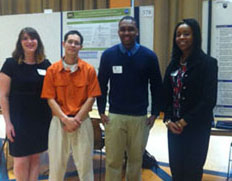News from the dePamphilis lab
Claude dePamphilis named Huck Chair in Plant Biology and Evolutionary Genomics
In June 2021, Claude dePamphilis was named the Dorothy Foehr Huck and J. Lloyd Huck Distinguished Chair in Plant Biology and Evolutionary Genomics by the Huck Institutes of the Life Sciences.
Parasitic plants use stolen genes to make them better parasites: Penn State News July 2019
A Penn State News feature article highlighted a recent dePamphilis Lab publication in Nature Plants in which 108 genes were identified in a dodder’s genome, acquired by horizontal gene transfer and apparently functional in the parasite, contributing to haustoria structure, defense responses, and amino acid metabolism. One stolen gene even produces small segments of RNA known as micro RNAs that are sent back into the host plant, acting as weapons that may play a role in silencing host defense genes. Eighteen of the 108 genes appear in all dodder species, suggesting that these genes were originally stolen by the ancestral form of dodder and are maintained in modern species. (Image credit: Joel McNeal, Kennesaw State University)
New NSF project to study disease resistance in tropical trees launches Jan., 2017
A new 3.6 Million NSF project to study disease resistance in tropical trees (including Cacao) kicks off in 2017. Claude dePamphilis will be a Co-PI on this project. Read the Penn State newswire announcement here.
Parasitic Plant Genome Project PNAS publication featured in Penn State News, 2016
Penn State Newswire highlighted a recent PPGP publication in PNAS showing that > 50 genes have been acquired by parasitic plants in the broomrape family from their hosts via horizontal gene transfer, and that these genes appear to be functional. These host-acquired genes may in turn be used by the parasites in defense mechanisms against their host plants. Read the Penn State feature and interview with Claude dePamphilis here.
PPGP annual planning meeting hosted at Penn State, Sept 2015

The dePamphilis Lab hosted the annual Parasitic Plant Genome Project PI planning meeting at Penn State, September 14-16, 2015. Approximately 30 people (PIs, post docs, grad students, technicians and other collaborators) from four institutions attended the three day meeting.
Amborella Draft Genome Published in Science, Dec 20, 2013.
Students from the dePamphilis Lab participate in Undergraduate Exhibit 2013

Three students from the dePamphilis Lab presented posters at the Penn State Undergraduate Exhibition in April. Nina Farrell, Emeka Egeruoh and Adaola Onyenaka presented the results of their work on the NSF Amborella Genome Project. With guidance from Josh Der, Project Manager, the students performed long-range PCR experiments to test the accuracy of optical mapping predictions for the Amborella trichopoda Genome. They also manually curated regions of the Amborella genome in order to evaluate the quality of several different automated gene prediction modelers and to identify problematic areas. Check out this nice feature photo of Adaola and our lab's work at the Undergraduate Exhibition.
The Amborella Genome Project funded in 2010
The dePamphilis Lab is excited to continue to study the origins and rapid diversification of early angiosperms through the NSF funded, mulit-institutional, Amborella Genome Project. Amborella trichopoda, occupies a special place in the plant tree of life, being a basal angiosperm and sister to all extant angiosperms. A genome sequence of Amborella will provide a foundation for all comparative analyses of angiosperm gene content and genome structure. This collaborative research project has enjoyed a great deal of media attention. To learn more, check out some of the press releases and interviews listed below.
Investigating ancestral polyploidy in plants at Penn State
Check out this very cool video made by the folks at CLC Bio. You'll learn about how the dePamphilis lab is studying the role of polyploidy in ancient angiosperms and their ancestors.
Research Unplugged Talk
Claude dePamphilis participated in Research Unplugged, an informal talk/discussion series hosted by Research Penn State, in April, 2009. He presented a talk entitled, "Primordial Plants: Lessons from Earth's Oldest Flowers." You can read the recap and listen to the podcast here.
Claude dePamphilis interviewed for Science magazine
The April 3, 2009 issue of Science included an article, "On the origin of flowering plants," in which Claude dePamphilis and other participants in the Floral Genome Project and the Ancestral Angeiosperm Project were interviewed. Read a summary of the article here. The Floral Genome Project and Ancestral Angeiosperm Project are funded by the National Science Foundation.
Tour the greenhouse with Research Penn State and Claude dePamphilis
The online version of a January 2009 Research Penn State article featuring Claude's research on ancestral angiosperms (flowering plants) includes a nifty virtual tour of some of Claude's favorite plants in the Biology Department greenhouses. Check out these very cool plants with Claude and read interview by Melissa Beattie-Moss here.
Probing Question: Why are flowers beautiful?
Claude dePamphilis was interviewed by Research Penn State reporter Lisa Duchene about the relationships that have evolved between flowering plants and their pollinators. See the January 2008 article online at Penn State LIVE.
NOVA: "First Flower"
In 2007, The PSB series, NOVA, broadcast an episode that focused on the origins of flowering plants. "First Flower" probes the controversial discovery of a Chinese fossil scientists believe may be the earliest evidence of a flower yet found on Earth. Following the trail of clues to the fossil's origins, a vivid journey takes NOVA's cameras deep into the lush wilds of China, a spectacular treasury of flowers both familiar and exotic. To learn more, visit http://www.pbs.org/wgbh/nova/flower/.
Genome Research (cover) paper on a massive polyploidy event early in the history of flowering plants featured in Science Journal
The Floral Genome Project may have found the answer to Darwin's "Abominable Mystery" about why flowering plants underwent such rapid diversification immediately after the first flowering plants appeared int he fossil record some 140 million years ago. Evidence uncovered by this research team suggests that a whole-genome duplication event occurred in the earliest flowering plants. After such a massive polyploidy event, having a full genome's worth of raw genetic material available to take on a new genetic funciton could drive rapid evolution. To learn more about this discovery, read the article in Fall 2006 issue of Penn State's Science Journal or read the original Genome Research Paper. This work was funded by the National Science Foundation.
Floral Genome Project
Our lab is proud to be taking part in The Floral Genome Project, which is which is investigating the origin, conservation, and diversification of the genetic architecture of the flower, and developing conceptual and real tools for evolutionary functional genomics in plants. Expression patterns are being evaluated for hundreds of genes in model species, and summarized in 3-D virtual reconstructions of developing flowers. This project will generate the first comparative data set of expression patterns for a large number of genes across diverse angiosperms. This multi-institutional project is being funded by the National Science Foundation. Read more about the Penn State contribution to the Floral Genome Project in Science Journal and Research Penn State.
dePamphilis lab Cuscuta work featured in Research Penn State
The January 2003 issue of Research Penn State features the work of graduate student, Joel McNeal (now at Harvard University), on Cuscuta rostrata, a parasitic plant responsible for millions of dollars of crop damage each year. This plant is a close relative of the Morning Glory, but it has developed haustoria, or sucker-like attachments that let it feed on host plants. Part of Joel's work involved comparing the chloroplast genomes of Cuscuta species and the tobacco plant, another close relative. While some sections of the chloroplast genomes of Cuscuta species were almost identical to the tobacco plant's, other sections are completely missing, probably due to the reduced need to manufacture their own food through photosynthesis. Here is a link to the article.
Barkman Water Lily Paper featured in Eberly Bulletin
The December 2000 issue of the Eberly College of Science Newsletter has a wonderful feature on the Barkman et al. 2000 paper in PNAS: "Independent and combined analyses of sequences from all three genomic compartments converge on the root of flowering plant phylogeny." You can link to the article here, or you can download the PDF file of the paper .
Rafflesia in the News
The parasitic flowering plant Rafflesia has gotten quite a bit of press in recent years. in Science News Vol. 156 (September 11, 1999), a three-page article was printed on Rafflesia past, present, and future. In it, there was mention of Dr. dePamphilis, including several quotes and a write-up on the current lab research. Then in March 2000, the youth-oriented magazine National Geographic World has a one page picture and short write-up on Rafflesia. For more information, take a look at the lab's Rafflesia page...
New Papers
For recent publication from the dePamphilis lab, check out the Papers/Publications page.